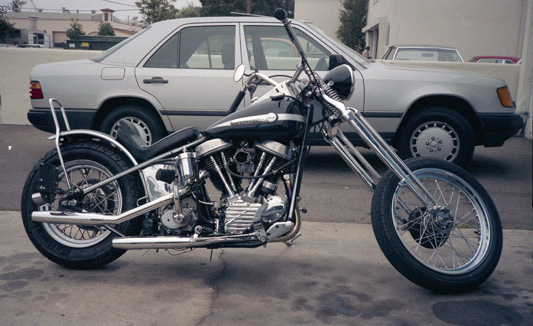
Chapter 6
Horton Building

The company's hyphenated name, Powell-Peralta, had a good sound to it. Stacy Peralta was the video producer, creator of the Bones Brigade team and former professional skater. He lived in Los Angeles and we rarely saw him. George Powell was the CEO, the manufacturer, and on the job in Santa Barbara every day. George was a Stanford-trained aerospace engineer, who skateboarded the campus in his college days back when skateboard wheels were made of clay. One day, years later, when his own teenage son, Abe, came home with the news that someone came up with the simple idea of making urethane wheels for skateboards, the light bulb over George's head clicked on. That was right up his alley. Thereafter he put all his engineering skills into making innovative and quality equipment for skateboarding.
About the time the Ver-Cal event took place, Facilities got a building of its own, around the corner from R&D. It was referred to as the Horton Building. Peter had an office in the front corner and the 2000 square foot big room had roll-up doors in the front and back, and another approximately 3000 square foot storage yard in back. Out in front, an unmarked space was reserved for George Powell's car. George was always friendly and approachable, quiet and restrained, understated, a bit hard to read, and over the few years I was there I came to think of him in terms that car. It was a Mercedes-Benz sedan, obviously his choice for the quality of engineering, and it was silver-gray, the most invisible finish available: a gray sedan. The mismatched collection of buildings that comprised the Powell offices, warehouses and production facilities were never painted or adorned with signage. Their exteriors all remained as we found them and there was no outward indication that the buildings were somehow a single manufacturing operation. That fact was invisible. Inside the focus of our actions was on the products. A year later when he purchased the big facility near the Santa Barbara Airport, he had the building completely renovated and upgraded in every way, remodeled to suit the needs of all our departments. And what color do you suppose he painted it? Gray. Actually, he went whole hog, ten shades of gray. Literally, I'm not kidding, ten different mixtures of black and white.
Imagine that underneath the bright colors of the graphics and wheels is the silver-gray Powell product of evolved engineering; and a big gray factory invisibly pumping out the top quality Powell-Peralta skateboard and wheels, the Mercedes-Benz of skateboarding. That's George's contribution, the unmatched quality of his invisible engineering. Stacy Peralta never had to feel like he was fronting for products that were anything other than the best equipment in the industry. Likewise, those videos that Stacy and the LA group produced were of a quality that George Powell could be proud. Powell-Peralta was a partnership that honored the quality of each other's creations.
For a skater, these videos are more than entertainment; they are training tapes. They are revelations of coordination and timing. The ollie, for instance, is a way of elevating a skateboard by means of a few flicks of the legs and feet, so as to be able to leap curbs initially, and thousands of variations. Just to see and experience the rhythm was key to picking up on what was evolving in the sport. So all you need is these simple devices; deck, trucks and wheels, and these videos to give you an entertaining lesson about how it's done. Just a few Powell-Peralta products are your keys to this worldwide amusement park; that, your evolving skills, and your willingness to take some lumps along the way.
Facilities had begun to share shop space with R&D in two garages with roll up doors. Chris' job was to devise methods of testing the company's products and various innovations. He had built a "guillotine" with ropes and pulleys that was designed to slam a weight down on a skateboard with adjustable force, to compare the breaking point of one contour or glue formula versus another. He would consult with the team riders on the individual shapes of their signature skateboards, and if we saw any of the Bones Brigade around our buildings in Santa Barbara they were there to see Chris about their deck, or to pow wow with Court across the street in the Art Department about their personal graphics, or touch base with Todd and George.
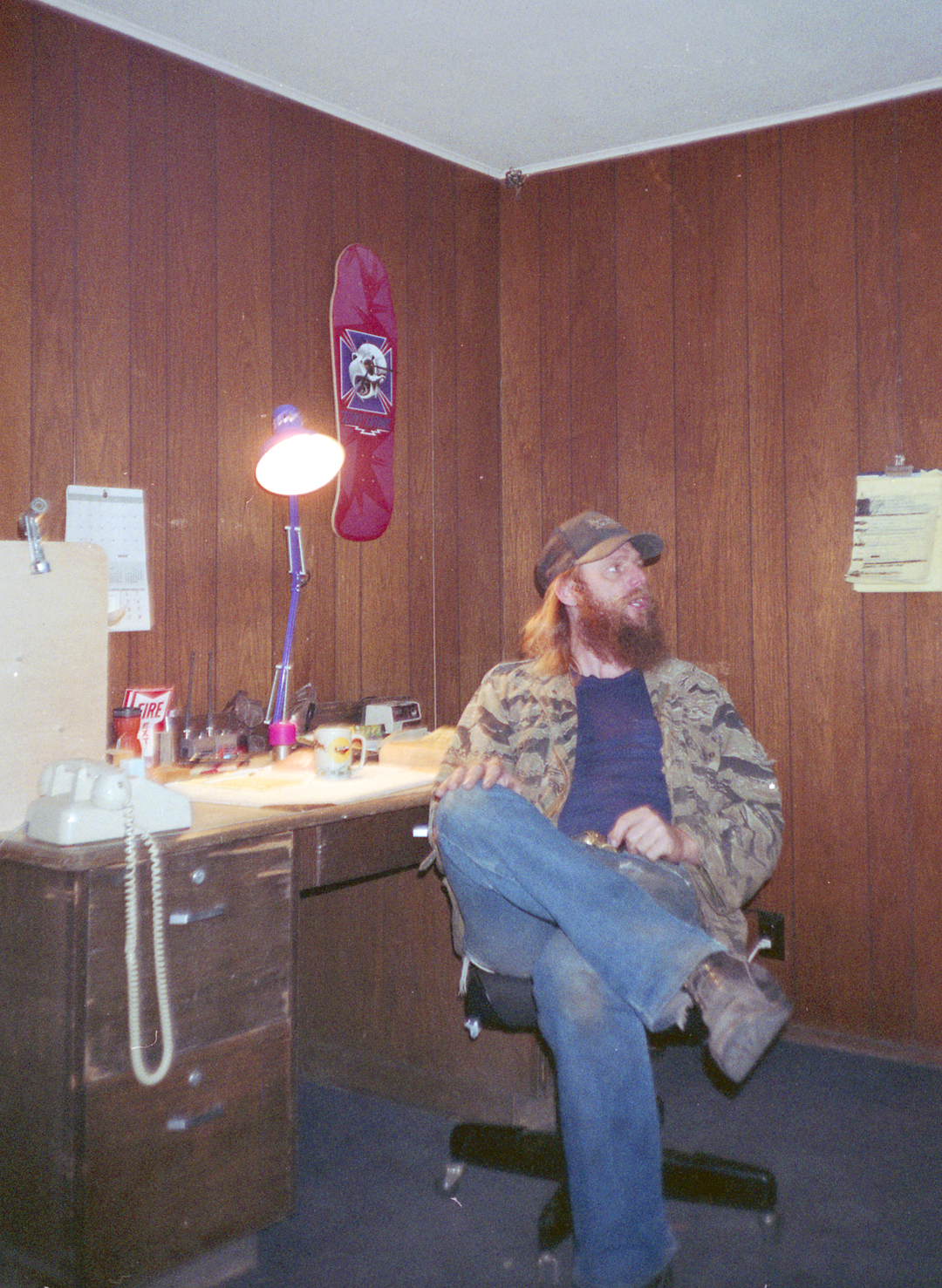
As soon as the Ver-Cal event was over, we had to remove the skating elements we had gathered there. That location was to become part of the expanding production of t-shirts and warehouse space. The big screenprinting autopress and drying oven were moved out of the Horton Building to the Ver-Cal Building. Facilities moved out of Chris' R&D shop, and took over the whole Horton Building. R&D doubled its space, and now Facilities had shop and yard space to spare. This was the beginning of serious volunteer ramp building efforts.
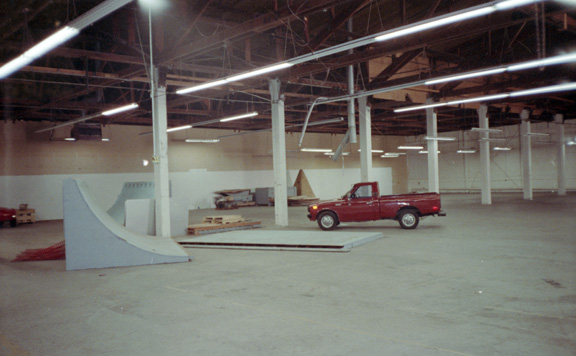
Chris Iverson had measured the space behind the Horton Building and had gotten permission to set up the Ver-Cal halfpipe there. One day he borrowed a huge forklift and a flatbed truck from somewhere and one by one carried the several sections of the halfpipe the 10 or so blocks from Ver-Cal to Horton. I jumped at the chance to be involved, and before long we had it set up, and I was able to get JW included. I must say that it was not at all difficult; everyone I dealt with there bent over backward to include JW and me in the fun. In particular, Joel, Peter, Ves, Chris Iverson, George Totten, and Todd Hastings; virtually everybody working there welcomed us and included us in every possible way.
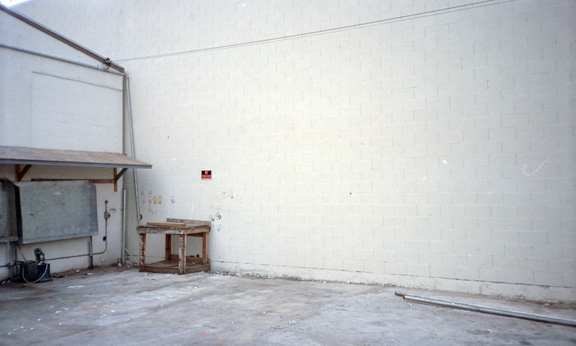
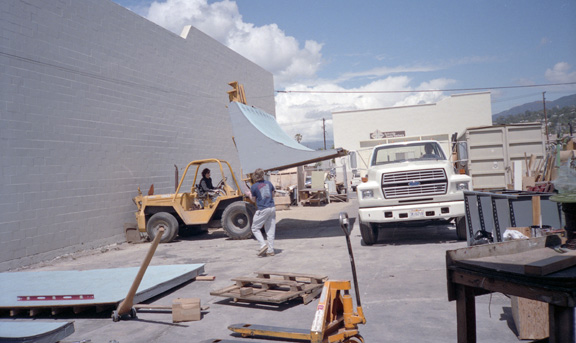
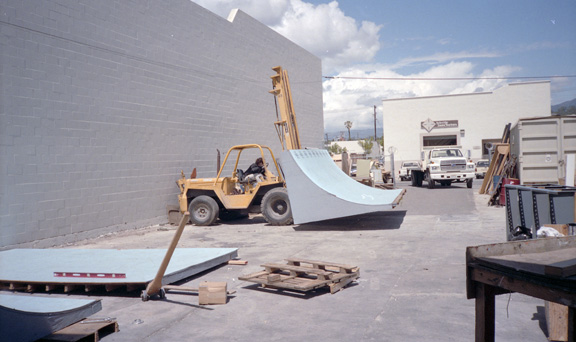
That halfpipe was the first ramp I got to work on that was built by someone who knew what he was doing. Mike Taylor was a skater who had worked at Powell in the early 1980's and had built a number of ramps before I had done my first attempt in Puna. Mike had stashed a small halfpipe in a field in Goleta. He had left town with the Barfoot snowboard team and was living near Lake Tahoe. In his absence, his ramp had been hijacked for the Ver-Cal event.
Highlighting the wisdom of recycle-ability, the halfpipe had been built in sections, "modular" you might say, so that it could have many reincarnations. Every wood framed skateboard ramp since then we built in the exact same way: Between identical 3/4" plywood bulkheads with the prescribed radius, a ladder of 2" x 4" joists are end nailed or screwed with one edge flush with the arc. Two sheets of 3/8" plywood are curved into place and screwed to the joists. On top of that, a Masonite layer for the skating surface. This makes each section 4 feet wide.
It had originally been built for a skateboard shop in Goleta. When the skateshop closed, Mike Taylor moved it to a field nearby. While he was out of town, it was successively reborn as the Ver-Cal ramp, and then alternatively referred to as the Horton Ramp or the Cross-Bones Ramp, for the company's graffiti style logo that had been silk-screened just below the coping for the Ver-Cal event.
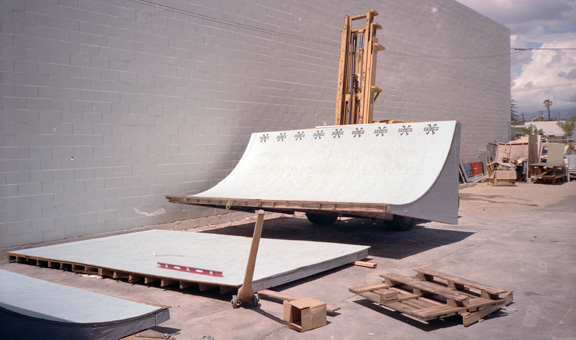
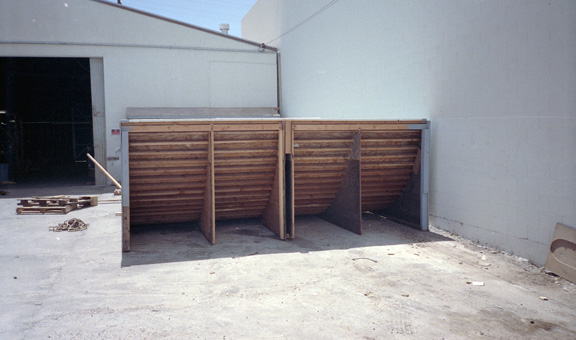
It fit neatly against a concrete block wall that was the backside of R&D's alley space, just outside of the Horton rear shop doors. We kept making improvements on it with wide rollouts with railings and netting to catch loose boards and a solid ladder.
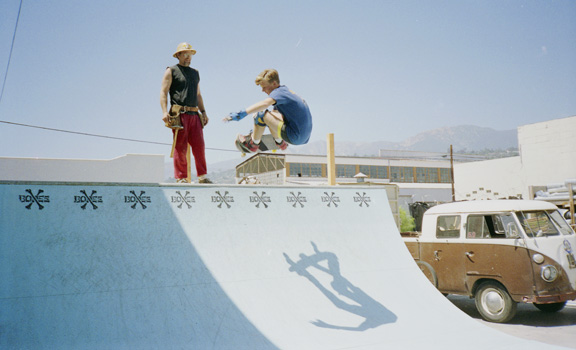
In the Horton building, Facilities had a proper shop, and the company had big plans for it. Among the Facilities crew, there were a few that could perform rudimentary welding, but Joel was looking to bring somebody truly skilled aboard. I didn't know what good welding was until I'd seen a master at work. Mike Frazier showed up in about February 1988. Joel was really excited about hiring him. There were two things Joel liked about him: one, he was a great welder, and second, when Joel asked him why he left his last job, he answered that he had beat up his supervisor. I'm pretty sure that's what clinched the job for him. Joel had a kind of quirky orneriness like that. He appreciated directness and he was looking to assemble a sort of pirate crew with a broad range of skills. Unclear how I fit in.
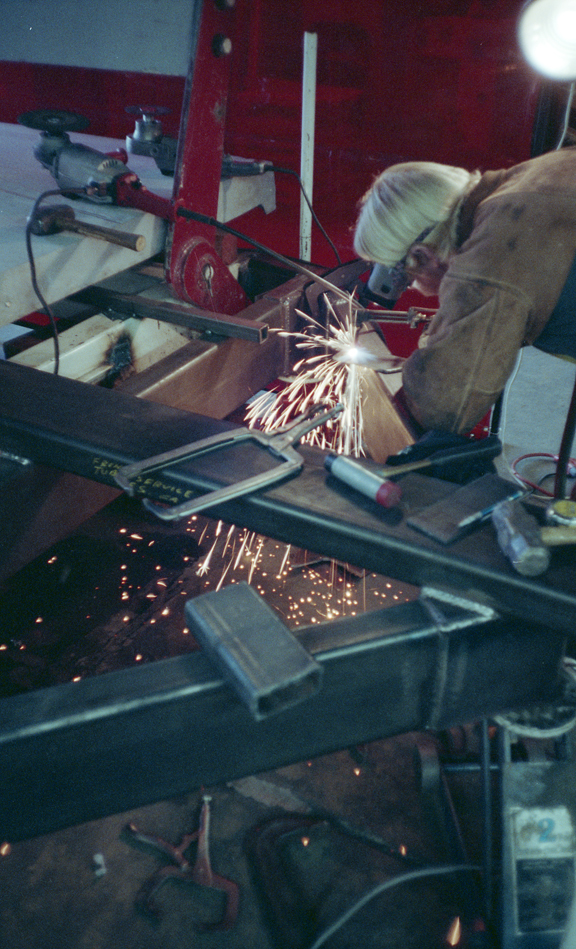
Mike Frazier was a virtuoso of welding. He could do it all. Before long the shop had acetylene torches, arc welders, MIG wire feed welders, and TIG welders, which are wire feed welders for aluminum. He could make steel bend and move with great artistry and control, just by putting the torch here and there. He could make it dance. From time to time, he had to take a week off to work his side gig, which was to apply his skills to Department of Defense projects involving the need for high-tech welding with extreme precision. He couldn't say much about the projects except to report that most of the time there, he sat on the sidelines, but when the time came, his skills were the main event. In his side job, his compensation was astronomical, making 3 times what he made at Powell.
Another character in our shop was Andy Trapasso, though nobody ever called him that. He went by "Moose". It was a fitting nickname. He was about 6'-7", with a scraggly beard and in his former days had been an East Coast Hell's Angel. He had among his collection of videotapes, just about every skateboard video ever made, and a copy of "Hell's Angels Forever" in which he had a short appearance, ambling through one scene, just barely recognizable. You could tell it was him by the way he walked or kind of ambled along like a huge bowling pin about to tip over; teetering to one side and then the other.
Moose lived in Carpinteria, and when I realized he was taking the bus to work, I began picking him up for the ride to Santa Barbara with me. He told me the tale of how he lost his privilege to drive. It involved getting seven drunk-driving tickets on his Harley, in one day. The judge told him that when he got out of jail, he would never, ever get a driver's license again. Which was why he had been riding the bus.
Another story he told me was the time he had been riding his motorcycle down the New Jersey Turnpike, I think it was, at a high rate of speed when a pigeon smacked him square in the middle of his forehead. The helmet he was wearing cracked right in half, he was knocked unconscious, crashed, and spent over a week in a coma. He said he never was the same. He was a good natured and comical character when I knew him though the word was, one time, when he was in the role of a bouncer, he became irritated and had broken the offender's legs, somehow. I didn't really want to know how.
Another one of Moose's claims to fame, in my mind at least, was that he had been a roadie for the Grateful Dead for a while, and had accompanied the band on their tour to Egypt in 1978. That fact had a lot of resonance for me, because at the time, in the late 1980's, several of my closest friends were working in the Grateful Dead organization in Northern California. I had been a big fan of the band since I took part in building a stage for them to perform on in 1969, through my communal days in San Francisco in the early 1970's, and forever after.
The core of our Facilities crew was a contingent of people; Joel, Peter, & Ves, who had worked together before at the defunct Clenet, a custom fancy car builder company that had built cars for the Sultan of Brunei and the like. One of the key people in the art department, Nick Dinapoli, had been the designer at Clenet. The art department was in a former paint store across the street from the Horton building. Nick was the competent leader of the department; did the designs and shop drawings for the trade show exhibits, and oversaw the artwork on all the products, but the real creative genius over there was Court Johnson.
Court Johnson, in addition to being the main artist, was the company's unofficial shaman, it seemed. He was usually dressed in a white shirt and white pants and wore roller skates all day. He would roll through all parts of the factory, stopping here and there among the factory workers to administer his own sort of "tune-ups," in which he would find and release the aches and pains of repetitive motion, and occasionally perform a sort of psychological release as well. His technique was to have you stand upright, relaxed, with your arm held out to the side, parallel to the ground, and he would place his hand on your arm, and ask you these formulaic questions: about your health, about your love life, about your money issues; and invariably, when he got to the issue that was bugging you, your arm would involuntarily weaken and dip under the constant light pressure of his hand. Once he located the crux of your distress, he spoke these affirmations: admonitions concerning the issue. For instance, when your arm dipped on the money question, he would speak a short phrase that reminded you of all the times when you'd come up against the money problem before, and that somehow you'd gotten through it.
Then there was James. James Gardner was the company's computer whiz, authority in electronics and all things electrical. James lived about three quarters the way up the mountains behind Santa Barbara. His Mom owned the 50 acres or so at Flores Flats, most the way up Gibraltar Road toward the ridge of the Santa Ynez Mountains, surrounded by National Forest lands. This was way off the grid. James had grown up running around wild in the surroundings of their isolated homestead. He only wore shoes when somebody required it of him. James was an early adopter of solar electric panels and deep cycle batteries, and by the late 80's had rigged up a Subaru with electric motors and golf cart batteries that he could commute down the mountain to work and make it all the way back up the winding road home on one charge.
The guy who turned out to be my closest buddy there was Gary Fowler. The name he preferred was "Ves", a name he had made up for himself. Ves had been part of the team at the Clenet auto works, like Joel and Peter. Ves had a variety of auto body related skills including painting. He was a surfer and also had surfboard-making chops: shaping, fiberglassing, and airbrushing. His brother was a well-known Santa Barbara surfboard maker. Ves had a number of personas, including that of a hippy. He always kept his hair long, never cut (as did Peter and Moose). He was a few years younger than me, about 40 at the time, and had the courage to take up skateboarding.
My own skateboarding experience began in the early 1970's. My friend Jim Hatch, aka "Steamboat" had been a bona fide beatnik. He was among the older bohemians that influenced me during those years and was part of our commune. He came up with some urethane wheeled skateboards in about 1971. We had a few experiences in the streets of San Francisco, including a certain paved playground out in the Richmond or Sunset district, I believe. It was composed of some asphalt terraces smoothly joined by asphalt slopes. It was quite fun, but I didn't take to skateboarding except in an occasional way.
Much later, in about 1975, we were all in Hawaii, and I decided to find out what my limits were. There was a long downhill two-lane road, Kahakai Blvd. leading down to the Hawaiian Beaches Subdivision to the home of a couple from our old communal family, Dick and Carol Latvala. Steamer and his wife Charlotte followed me in their rented car. I was picking up quite a bit of speed and I could see I was coming to a very rough stretch of pavement.
I hadn't developed the skills needed to stop, or even slow down. At the same time, I could see a car coming the other way and calculated that I would reach the rough spot about the same time as the oncoming car. I envisioned losing control and ending up under its wheels or as a bug on its windshield. I chose to bail out. Veering toward the right shoulder, I jumped off and tried to get my legs running as fast as I was moving, taking about three steps in 25 feet before my momentum had me hurtling toward the ground and rolling on the rocky rubble beside the road. Coming to rest in a jumble of lava rocks, ferns and popcorn Vanda orchids, I was one banged up haole. I had scrapes, cuts and bruises all over.
Skating skills are gained incrementally, and the most avoidable injuries happen when you attempt more than you're ready for; my Kahakai bailout is a prime example of that. Though I was always supportive of JW's skating, that slam ended my interest in getting on a skateboard myself until 1987, when I went to work for Powell-Peralta.
Anyway, getting back to Ves, we both began to learn to skateboard, but I soon found out, at this age, 44, with all the twists and turns necessary to skate, my body hurt even when I didn't fall down. I decided to hang it up, and stick to rampbuilding and taking pictures. Ves however, continued, and became skilled enough to skate all sorts of terrain including dropping in on the Horton halfpipe, and pulling it off. Over the following years, he continued to skate, and would often show up at work limping, tweaked or scraped in one way or another. He took a bad fall at Moguls above the Tea Bowl, damaging some internal organs. He had lot more willingness to take the lumps than me. He kept on skating. He was the crash dummy that kept reminding me I'd made a good decision. Finally, and most important, Ves was funny. He was a natural funnyman and clown. In fact, everybody in that whole Facilities brigade was funny. Ves was especially funny.

One of the first uses of our shop in the Horton Building was to build one of the big trade show exhibits for the ASR show in Long Beach. This particular exhibit was meant to showcase and emphasize Powell-Peralta's return to the use of seven plys of hard rock maple, after having experimented with something called "Bone-ite," where some of the plys in the lamination of our skateboards were of a high tech cellulose composite. In use, Bone-ite hadn't performed as well as expected, and the company wanted to highlight its commitment to return to the all-maple laminations. The theme of the exhibit, directed at action sports retailers, was gold: gold that the skateshop owners would reap selling Powell-Peralta products. Everything in the exhibit was to be gold. The walls were gold, the flyers were gold, the sales people were dressed in gold, and the video cabinet stands that it was my job to create, were upholstered in gold diamond pleated naugahyde. The centerpiece of the exhibit was a gold naugahyde pyramid, which I also got to build.
The pyramid was 8 feet tall and 4 feet square at the base. It was meant to be reminiscent of an old-time fortune telling booth. It had a viewing hole at eye level and a button you were to push when you looked in. Inside, we had rigged up the art department's mascot, a full size anatomically correct medical school skeleton named Rosie. She was seated on a simple seat painted flat black. When the button was pushed, a strobe light flickered inside and a buzzing solenoid animated her right hand so that it came up toward the eyehole displaying a hand of playing cards. The seven cards of the hand were seven plys of our hard rock maple, foretelling the future in seven ply maple skateboards.

Bone-ite was the only product failure I was aware of during my time at Powell. There were, however, occasional defects or defective runs in decks and wheels. One of our chores in Facilities was to destroy the defects before discarding them. The dumpsters at the company were regularly raided by local skaters, and efforts were made to put nothing usable in them, especially defective product.
The Gold pyramid signaled the end of the Bone-ite experiment.
In an odd chain of events, long after I left the company and moved up north, the gold pyramid ended up at the "Big House", the Allman Brothers Museum in Macon, Georgia, where it has been since 1999. Long story.
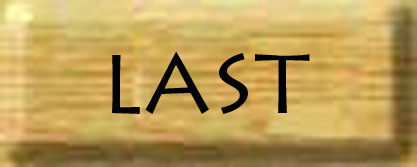

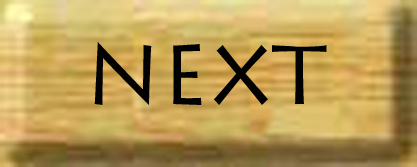

© 2017, 2022 John Oliver
All Rights Reserved
mail@unclejohnsweb.com
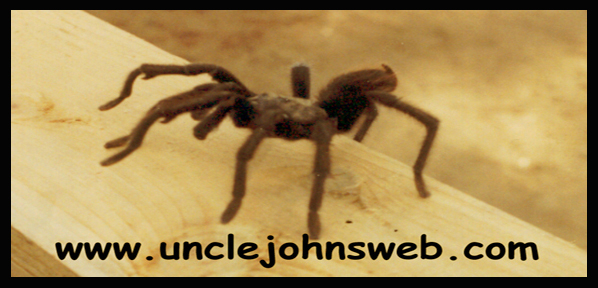
About the time the Ver-Cal event took place, Facilities got a building of its own, around the corner from R&D. It was referred to as the Horton Building. Peter had an office in the front corner and the 2000 square foot big room had roll-up doors in the front and back, and another approximately 3000 square foot storage yard in back. Out in front, an unmarked space was reserved for George Powell's car. George was always friendly and approachable, quiet and restrained, understated, a bit hard to read, and over the few years I was there I came to think of him in terms that car. It was a Mercedes-Benz sedan, obviously his choice for the quality of engineering, and it was silver-gray, the most invisible finish available: a gray sedan. The mismatched collection of buildings that comprised the Powell offices, warehouses and production facilities were never painted or adorned with signage. Their exteriors all remained as we found them and there was no outward indication that the buildings were somehow a single manufacturing operation. That fact was invisible. Inside the focus of our actions was on the products. A year later when he purchased the big facility near the Santa Barbara Airport, he had the building completely renovated and upgraded in every way, remodeled to suit the needs of all our departments. And what color do you suppose he painted it? Gray. Actually, he went whole hog, ten shades of gray. Literally, I'm not kidding, ten different mixtures of black and white.
Imagine that underneath the bright colors of the graphics and wheels is the silver-gray Powell product of evolved engineering; and a big gray factory invisibly pumping out the top quality Powell-Peralta skateboard and wheels, the Mercedes-Benz of skateboarding. That's George's contribution, the unmatched quality of his invisible engineering. Stacy Peralta never had to feel like he was fronting for products that were anything other than the best equipment in the industry. Likewise, those videos that Stacy and the LA group produced were of a quality that George Powell could be proud. Powell-Peralta was a partnership that honored the quality of each other's creations.
For a skater, these videos are more than entertainment; they are training tapes. They are revelations of coordination and timing. The ollie, for instance, is a way of elevating a skateboard by means of a few flicks of the legs and feet, so as to be able to leap curbs initially, and thousands of variations. Just to see and experience the rhythm was key to picking up on what was evolving in the sport. So all you need is these simple devices; deck, trucks and wheels, and these videos to give you an entertaining lesson about how it's done. Just a few Powell-Peralta products are your keys to this worldwide amusement park; that, your evolving skills, and your willingness to take some lumps along the way.
Facilities had begun to share shop space with R&D in two garages with roll up doors. Chris' job was to devise methods of testing the company's products and various innovations. He had built a "guillotine" with ropes and pulleys that was designed to slam a weight down on a skateboard with adjustable force, to compare the breaking point of one contour or glue formula versus another. He would consult with the team riders on the individual shapes of their signature skateboards, and if we saw any of the Bones Brigade around our buildings in Santa Barbara they were there to see Chris about their deck, or to pow wow with Court across the street in the Art Department about their personal graphics, or touch base with Todd and George.





It had originally been built for a skateboard shop in Goleta. When the skateshop closed, Mike Taylor moved it to a field nearby. While he was out of town, it was successively reborn as the Ver-Cal ramp, and then alternatively referred to as the Horton Ramp or the Cross-Bones Ramp, for the company's graffiti style logo that had been silk-screened just below the coping for the Ver-Cal event.





Moose lived in Carpinteria, and when I realized he was taking the bus to work, I began picking him up for the ride to Santa Barbara with me. He told me the tale of how he lost his privilege to drive. It involved getting seven drunk-driving tickets on his Harley, in one day. The judge told him that when he got out of jail, he would never, ever get a driver's license again. Which was why he had been riding the bus.
Another story he told me was the time he had been riding his motorcycle down the New Jersey Turnpike, I think it was, at a high rate of speed when a pigeon smacked him square in the middle of his forehead. The helmet he was wearing cracked right in half, he was knocked unconscious, crashed, and spent over a week in a coma. He said he never was the same. He was a good natured and comical character when I knew him though the word was, one time, when he was in the role of a bouncer, he became irritated and had broken the offender's legs, somehow. I didn't really want to know how.
Another one of Moose's claims to fame, in my mind at least, was that he had been a roadie for the Grateful Dead for a while, and had accompanied the band on their tour to Egypt in 1978. That fact had a lot of resonance for me, because at the time, in the late 1980's, several of my closest friends were working in the Grateful Dead organization in Northern California. I had been a big fan of the band since I took part in building a stage for them to perform on in 1969, through my communal days in San Francisco in the early 1970's, and forever after.
The core of our Facilities crew was a contingent of people; Joel, Peter, & Ves, who had worked together before at the defunct Clenet, a custom fancy car builder company that had built cars for the Sultan of Brunei and the like. One of the key people in the art department, Nick Dinapoli, had been the designer at Clenet. The art department was in a former paint store across the street from the Horton building. Nick was the competent leader of the department; did the designs and shop drawings for the trade show exhibits, and oversaw the artwork on all the products, but the real creative genius over there was Court Johnson.
Court Johnson, in addition to being the main artist, was the company's unofficial shaman, it seemed. He was usually dressed in a white shirt and white pants and wore roller skates all day. He would roll through all parts of the factory, stopping here and there among the factory workers to administer his own sort of "tune-ups," in which he would find and release the aches and pains of repetitive motion, and occasionally perform a sort of psychological release as well. His technique was to have you stand upright, relaxed, with your arm held out to the side, parallel to the ground, and he would place his hand on your arm, and ask you these formulaic questions: about your health, about your love life, about your money issues; and invariably, when he got to the issue that was bugging you, your arm would involuntarily weaken and dip under the constant light pressure of his hand. Once he located the crux of your distress, he spoke these affirmations: admonitions concerning the issue. For instance, when your arm dipped on the money question, he would speak a short phrase that reminded you of all the times when you'd come up against the money problem before, and that somehow you'd gotten through it.
Then there was James. James Gardner was the company's computer whiz, authority in electronics and all things electrical. James lived about three quarters the way up the mountains behind Santa Barbara. His Mom owned the 50 acres or so at Flores Flats, most the way up Gibraltar Road toward the ridge of the Santa Ynez Mountains, surrounded by National Forest lands. This was way off the grid. James had grown up running around wild in the surroundings of their isolated homestead. He only wore shoes when somebody required it of him. James was an early adopter of solar electric panels and deep cycle batteries, and by the late 80's had rigged up a Subaru with electric motors and golf cart batteries that he could commute down the mountain to work and make it all the way back up the winding road home on one charge.
The guy who turned out to be my closest buddy there was Gary Fowler. The name he preferred was "Ves", a name he had made up for himself. Ves had been part of the team at the Clenet auto works, like Joel and Peter. Ves had a variety of auto body related skills including painting. He was a surfer and also had surfboard-making chops: shaping, fiberglassing, and airbrushing. His brother was a well-known Santa Barbara surfboard maker. Ves had a number of personas, including that of a hippy. He always kept his hair long, never cut (as did Peter and Moose). He was a few years younger than me, about 40 at the time, and had the courage to take up skateboarding.
My own skateboarding experience began in the early 1970's. My friend Jim Hatch, aka "Steamboat" had been a bona fide beatnik. He was among the older bohemians that influenced me during those years and was part of our commune. He came up with some urethane wheeled skateboards in about 1971. We had a few experiences in the streets of San Francisco, including a certain paved playground out in the Richmond or Sunset district, I believe. It was composed of some asphalt terraces smoothly joined by asphalt slopes. It was quite fun, but I didn't take to skateboarding except in an occasional way.
Much later, in about 1975, we were all in Hawaii, and I decided to find out what my limits were. There was a long downhill two-lane road, Kahakai Blvd. leading down to the Hawaiian Beaches Subdivision to the home of a couple from our old communal family, Dick and Carol Latvala. Steamer and his wife Charlotte followed me in their rented car. I was picking up quite a bit of speed and I could see I was coming to a very rough stretch of pavement. I hadn't developed the skills needed to stop, or even slow down. At the same time, I could see a car coming the other way and calculated that I would reach the rough spot about the same time as the oncoming car. I envisioned losing control and ending up under its wheels or as a bug on its windshield. I chose to bail out. Veering toward the right shoulder, I jumped off and tried to get my legs running as fast as I was moving, taking about three steps in 25 feet before my momentum had me hurtling toward the ground and rolling on the rocky rubble beside the road. Coming to rest in a jumble of lava rocks, ferns and popcorn Vanda orchids, I was one banged up haole. I had scrapes, cuts and bruises all over.
Skating skills are gained incrementally, and the most avoidable injuries happen when you attempt more than you're ready for; my Kahakai bailout is a prime example of that. Though I was always supportive of JW's skating, that slam ended my interest in getting on a skateboard myself until 1987, when I went to work for Powell-Peralta.
Anyway, getting back to Ves, we both began to learn to skateboard, but I soon found out, at this age, 44, with all the twists and turns necessary to skate, my body hurt even when I didn't fall down. I decided to hang it up, and stick to rampbuilding and taking pictures. Ves however, continued, and became skilled enough to skate all sorts of terrain including dropping in on the Horton halfpipe, and pulling it off. Over the following years, he continued to skate, and would often show up at work limping, tweaked or scraped in one way or another. He took a bad fall at Moguls above the Tea Bowl, damaging some internal organs. He had lot more willingness to take the lumps than me. He kept on skating. He was the crash dummy that kept reminding me I'd made a good decision. Finally, and most important, Ves was funny. He was a natural funnyman and clown. In fact, everybody in that whole Facilities brigade was funny. Ves was especially funny.


Bone-ite was the only product failure I was aware of during my time at Powell. There were, however, occasional defects or defective runs in decks and wheels. One of our chores in Facilities was to destroy the defects before discarding them. The dumpsters at the company were regularly raided by local skaters, and efforts were made to put nothing usable in them, especially defective product. The Gold pyramid signaled the end of the Bone-ite experiment.
In an odd chain of events, long after I left the company and moved up north, the gold pyramid ended up at the "Big House", the Allman Brothers Museum in Macon, Georgia, where it has been since 1999. Long story.




© 2017, 2022 John Oliver
All Rights Reserved
mail@unclejohnsweb.com

All Rights Reserved
mail@unclejohnsweb.com
